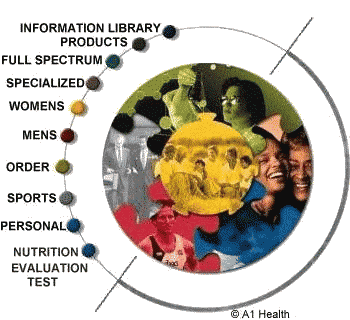COLLOIDAL MINERALS
What is the use and function of MANGANESE ?
Manganese (Mn) is an essential trace mineral that is concentrated primarily
in the bone, liver, pancreas, and brain. This mineral is a component of several
enzymes:
-
Mn-superoxide dismutase which prevents tissue damage due to lipid (fat)
oxidation
- Arginase which helps forms the urea in the urine from the amino acid
arginine
- Pyruvate carboxylase which helps break down carbohydrates.
Manganese also activates numerous enzymes, particularly glycosyltransferases
which are involved with the formation of cartilage in bone and skin.
Manganese is also an antioxidant nutrient; important in the blood breakdown
of amino acids and the production of energy; necessary for the metabolism
of Vitamin B-1 & Vitamin E; Activates various enzymes which are important
for proper digestion & utilization of foods; is a catalyst in the breakdown
of fats & cholesterol; helps nourish the nerves and brain; necessary for
normal skeletal development; maintains sex hormone production.
DEFICIENCY SYMPTOMS:
May result in paralysis, convulsions, dizziness, ataxia, loss of hearing,
digestive problems, blindness and deafness in infants.
In animals manganese deficiencies produce abnormalities in brain function,
glucose tolerance, reproduction, and skeletal and cartilage formation.
In humans, gross deficiencies have not been documented in free-living
populations but deficiencies created in a metabolic unit suggest the mineral
is important to maintain the integrity of the skin, bone and menstrual
cycle, and in cholesterol metabolism. Certain population groups have been
reported to have suboptimal status, including children with birth defects
or on long-term total parenteral nutrition and patients with Perthes'
disease, hip dislocations in Down's syndrome, osteoporosis, multiple sclerosis,
non-trauma epilepsy, senile cataracts, acromegaly, and amyotrophic lateral
sclerosis.
Diet recommendations: The Estimated Safe and Adequate Dietary
Intakes (ESADDIs) for Mn are:
|
Age (years) |
mg/day |
| Infants |
0-0.5 |
0.3-0.6 |
|
0.5-1.0 |
0.6-1.0 |
| Children |
1-3 |
1.0-1.5 |
|
4-6 |
1.5-2.0 |
|
7-10 |
2.0-3.0 |
|
11-14 |
2.0-5.0 |
| Adults |
|
2.0-5.0 |
Usual dietary intakes in the U.S. are about 2.2 and 2.8 mg/day
for adult women and men, respectively. However, much higher intakes
(10-18 mg) are found with vegetarian diets and those based on whole-grain
products. Thus, the current ESADDI may be too conservative for adults.
Food sources: Excellent sources of manganese (>1
mg/serving) include pecans, peanuts, pineapple fruit and juice, oatmeal,
shredded wheat and raisin bran cereal. Good sources (> 0.5
mg/serving) are beans (pinto, lima, navy), rice, spinach, sweet potato,
and whole wheat bread. Almost no Mn is found in meat, poultry, fish,
milk, dairy products or sugary and refined foods.
Dietary components that may adversely affect manganese absorption,
retention or excretion include iron, phosphorus, phytates, fiber,
calcium, copper, and polyphenolic compounds.
Toxicity: Toxicity has occurred from industrial exposure,
such as miners breathing manganese dust and drinking contaminated
well water. Symptoms of toxicity are the development of a schizophrenia
with nervous disorders resembling Parkinson's disease. The reference
dose (RfD) set by the EPA in 1993 is 10 mg/day for a 70 kg body weight;
this dietary level is considered to be without significant risk of
a deleterious effect for a lifetime of exposure. But there is no evidence
of toxicity occurring from ingestion of typical diets. For drinking
water, the RfD is 0.2 mg Mn/L.
Recent research: Lower manganese bloods levels have been
observed in patients with osteoporosis, non-trauma epilepsy and Perthes'
disease. Magnetic resonance imaging (MRI) is a very sensitive technique
that can detect toxic accumulation in the brain.
For further information:
Freeland-Graves, J. (1994) Derivation of Manganese Estimated Safe
and Daily Dietary Intakes. In: Risk Assessment of Essential Elements
(Mertz, C., Abernathy, C. & Olin, S.S., eds.), pp. 237-252. International
Life Sciences Institute Press, Washington, D.C.
Penland, J. & Johnson, P. (1993) Dietary manganese and calcium
effects on menstrual cycle symptoms. Am. J. Obstet. Gynecol. 168:
1417-1423.
 LIBRARY LIBRARY
CHROMIUM
RELATED ARTICLES:
 NEWS ARTICLE: CHEMISTRY'S MIRACULOUS COLLOIDS NEWS ARTICLE: CHEMISTRY'S MIRACULOUS COLLOIDS
Reprint from READERS DIGEST - March 1936
 Metallic iodine vs Organic Metallic iodine vs Organic
 CHRONIC FATIGUE SYNDROME CHRONIC FATIGUE SYNDROME
 REQUEST YOUR FREE EAGLE PRODUCT
INFORMATION PACK: INFOPACK@eagle-min.com REQUEST YOUR FREE EAGLE PRODUCT
INFORMATION PACK: INFOPACK@eagle-min.com

INDEPENDENT
SupraLife Distributor
For personal service Call:
A1 Health
TOLL FREE ORDER EXPRESS HOT LINE :888-441-4184
9 AM Till 7PM EST
 e-mail: info@colloidal-min.com e-mail: info@colloidal-min.com
|
